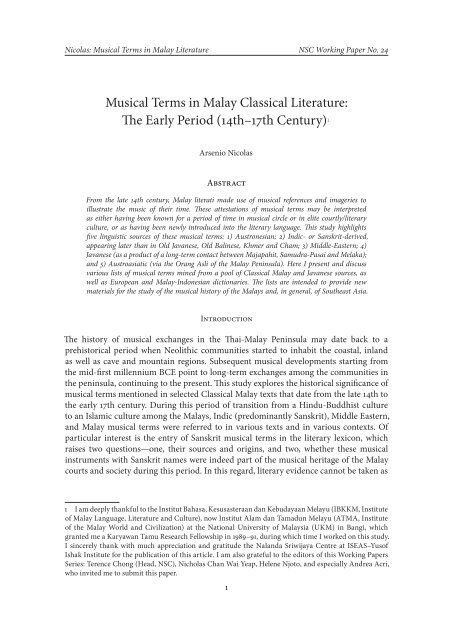2k2ADzp
2k2ADzp
2k2ADzp
You also want an ePaper? Increase the reach of your titles
YUMPU automatically turns print PDFs into web optimized ePapers that Google loves.
Nicolas: Musical Terms in Malay Literature NSC Working Paper No. 24<br />
Musical Terms in Malay Classical Literature:<br />
The Early Period (14th–17th Century) 1<br />
Arsenio Nicolas<br />
Abstract<br />
From the late 14th century, Malay literati made use of musical references and imageries to<br />
illustrate the music of their time. These attestations of musical terms may be interpreted<br />
as either having been known for a period of time in musical circle or in elite courtly/literary<br />
culture, or as having been newly introduced into the literary language. This study highlights<br />
five linguistic sources of these musical terms: 1) Austronesian; 2) Indic- or Sanskrit-derived,<br />
appearing later than in Old Javanese, Old Balinese, Khmer and Cham; 3) Middle-Eastern; 4)<br />
Javanese (as a product of a long-term contact between Majapahit, Samudra-Pasai and Melaka);<br />
and 5) Austroasiatic (via the Orang Asli of the Malay Peninsula). Here I present and discuss<br />
various lists of musical terms mined from a pool of Classical Malay and Javanese sources, as<br />
well as European and Malay-Indonesian dictionaries. The lists are intended to provide new<br />
materials for the study of the musical history of the Malays and, in general, of Southeast Asia.<br />
Introduction<br />
The history of musical exchanges in the Thai-Malay Peninsula may date back to a<br />
prehistorical period when Neolithic communities started to inhabit the coastal, inland<br />
as well as cave and mountain regions. Subsequent musical developments starting from<br />
the mid-first millennium BCE point to long-term exchanges among the communities in<br />
the peninsula, continuing to the present. This study explores the historical significance of<br />
musical terms mentioned in selected Classical Malay texts that date from the late 14th to<br />
the early 17th century. During this period of transition from a Hindu-Buddhist culture<br />
to an Islamic culture among the Malays, Indic (predominantly Sanskrit), Middle Eastern,<br />
and Malay musical terms were referred to in various texts and in various contexts. Of<br />
particular interest is the entry of Sanskrit musical terms in the literary lexicon, which<br />
raises two questions—one, their sources and origins, and two, whether these musical<br />
instruments with Sanskrit names were indeed part of the musical heritage of the Malay<br />
courts and society during this period. In this regard, literary evidence cannot be taken as<br />
1 I am deeply thankful to the Institut Bahasa, Kesusasteraan dan Kebudayaan Melayu (IBKKM, Institute<br />
of Malay Language, Literature and Culture), now Institut Alam dan Tamadun Melayu (ATMA, Institute<br />
of the Malay World and Civilization) at the National University of Malaysia (UKM) in Bangi, which<br />
granted me a Karyawan Tamu Research Fellowship in 1989–91, during which time I worked on this study.<br />
I sincerely thank with much appreciation and gratitude the Nalanda Sriwijaya Centre at ISEAS–Yusof<br />
Ishak Institute for the publication of this article. I am also grateful to the editors of this Working Papers<br />
Series: Terence Chong (Head, NSC), Nicholas Chan Wai Yeap, Helene Njoto, and especially Andrea Acri,<br />
who invited me to submit this paper.<br />
1


